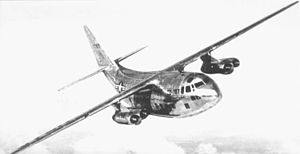Chase XC-123A
| XC-123A | |
|---|---|
 |
|
| Role | Military transport aircraft |
| Manufacturer | Chase Aircraft |
| Designer | Michael Stroukoff |
| First flight | 21 April 1951 |
| Primary user | United States Air Force |
| Number built | 1 |
| Developed from | Chase XCG-20 |
| Career | |
| Other name(s) | Jet Avitruc |
| Serial | 47-787 |
| Fate | Converted to YC-123D 53-8068 |
The Chase XC-123A was an experimental transport aircraft developed by Chase Aircraft. The first jet-powered transport built for the United States Air Force, it was intended for use as a high-speed transport for high-priority cargo and personnel. The XC-123A was determined to have insufficient advantages over existing types in service, and did not go into production. The sole prototype was converted into the piston-powered Stroukoff YC-123D to evaulate boundary layer control systems; following the conclusion of testing, it was sold onto the civilian market, and still exists, having been converted to turboprop power.
In the late 1940s, Chase Aircraft had developed the XG-20, the largest glider ever built in the United States. By the time it was ready for operations, however, U.S. military doctrine had been altered to remove the requirement for the use of transport gliders in combat.
However, the XG-20's aircraft had been designed to allow for the easy installation of powerplants, and Chase modified the two prototypes into powered aircraft, one becoming the XC-123, with twin piston engines. The second XG-20, however, was taken in hand for a more radical reconfiguration, being fitted with two twin-jet engine pods, of the type used by the Convair B-36 and Boeing B-47 bombers, to become the XC-123A. As there was no provision for housing fuel in the former glider's wings, fuel tanks were installed underneath the cabin floor.
Dubbed "Avitruc" by its manufacturer, the XC-123A conducted its maiden flight on April 21, 1951, becoming the first jet-powered transport aircraft to successfully fly in the United States. It was considered "excellent" in flight trials, with the aircraft showing few vices, and demonstrating reasonably good short-field capability.
Despite this, even as the XC-123 proved successful, the XC-123A failed to win sufficient favor in flight testing to receive a production order. Although the aircraft's short-field performance was good, on rough, unimproved fields the low-slung jet pods would suck debris into the intakes, damaging the engines. In addition, the aircraft's design was mismatched to its engines, resulting in the XC-123A being incapable of providing sufficient cargo capacity compared to the amount of fuel its jet engines required. As a result, the XC-123A project was abandoned without additional aircraft being built.
...
Wikipedia
